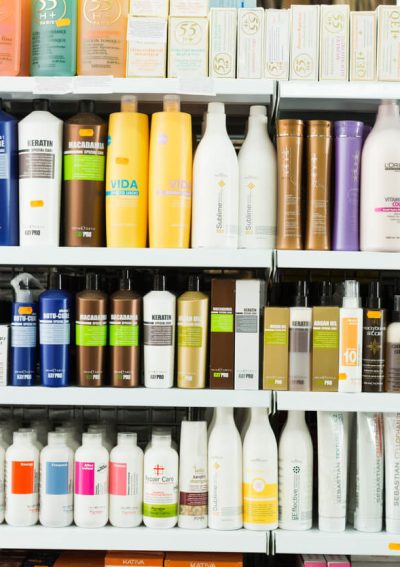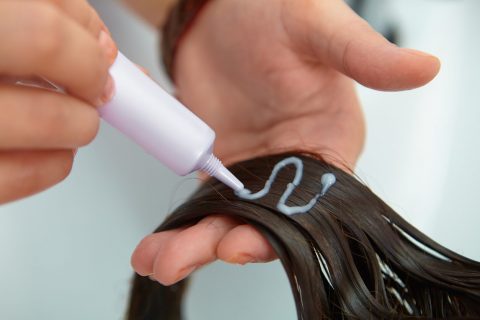Chemical Hair Straightener Side Effects
Short-term effects of hair relaxers include hair loss and damage to the hair shaft. There are also severe side effects of chemical hair straightening. Studies show toxic chemicals in hair relaxers are linked to certain cancers and other serious illnesses.

Common Side Effects of Chemical Hair Straightening
The most common side effects of chemical hair straighteners and relaxers are hair damage and skin irritation. However, the ingredients in many hair relaxers are also associated with some severe hazards to your health.
Widely used and potentially harmful compounds found in many chemical hair straightening products include benzophenone-3, cyclosiloxanes, diethanolamine, formaldehyde, parabens, phthalates, sodium hydroxide and triclosan.
“Chemical hair relaxers often contain strong alkaline agents like sodium hydroxide, guanidine hydroxide or ammonium thioglycolate,” Dr. Janet Vafaie, MD, FAAD, a Board-Certified Dermatologist, told Consumer Notice. “Over time, they may weaken the hair shaft, leading to breakage and permanent hair loss due to scarring alopecia.”
- Adverse pregnancy outcomes like premature birth or low birth weight
- Allergic sensitization
- Asthma attacks
- Burns and irritation of the skin, eyes and lungs
- Endocrine disruption
- Hair loss
- Impaired fertility or infertility
- Potential increased risk of cancer, including breast, endometrial and uterine cancer
- Respiratory issues
- Vision loss
Regulations on Chemical Hair Straighteners
The World Health Organization’s International Agency for Research on Cancer classifies formaldehyde, a key ingredient in many hair relaxers, as a carcinogen.
Some governments, like Brazil and Canada, have prohibited or limited the use of formaldehyde in chemical hair straighteners. The Nigerian government issued a warning against using hair products containing formaldehyde.
The U.S. Food and Drug Administration (FDA) has repeatedly missed deadlines to rule on banning formaldehyde-containing hair relaxers. However, in October 2024, they released a fact sheet warning consumers and salon professionals to be careful with these products.
According to the agency, you should check labels for ingredients like formalin or methylene glycol and look out for skin irritation and breathing problems. If the ingredients aren’t clear, consult your stylist or choose a different product. If you experience adverse reactions, report them to your doctor and the FDA.
The Occupational Safety and Health Administration requires salons to have proper ventilation since heating these products can release formaldehyde gas. Salons should follow safety regulations to limit formaldehyde exposure in the air.
Long-Term Effects of Chemical Hair Straighteners
A 2022 National Institutes of Health study found that women who used chemical hair straightening products at least four times in the previous year were more than twice as likely to develop uterine cancer than those who did not.
Dr. Alexandra White, head of the National Institutes of Health’s Environment and Cancer Epidemiology group and lead author on the new study, noted, “This doubling rate is concerning. However, it is important to put this information into context – uterine cancer is a relatively rare type of cancer.”
National Institutes of Health researchers previously reported on the link between hair straightening products and cancer, finding increased risk for both breast and ovarian cancers. Women who used hair straighteners at least every five to eight weeks were about 30% more likely to develop breast cancer.
The authors state that study results must be replicated before medical professionals can make more firm recommendations about chemical hair straighteners and cancer.
Some consumers who developed severe side effects, including uterine cancer, have begun filing chemical hair straightener lawsuits against beauty industry brands selling these products.
As of April 2025, there were 9,936 pending lawsuits in a hair straightener multidistrict litigation (MDL) in an Illinois federal court.
Alternatives to Chemical Hair Straightening
The best way to avoid the side effects of chemical hair relaxers is to use alternative methods to straighten your hair. While nonchemical hair straightening methods vary in effectiveness, experimenting with them is typically safe. For example, flat irons are safe but may damage hair if overused.
- Wrapping hair
- Using large rollers
- Blow drying with cold air
- Applying hair masks or essential oils
Using a natural product like coconut oil can help to relax the cuticle and eliminate frizz.
Is Chemical Hair Straightening Safe?
If you are a consumer or a hair stylist who uses hair straightening treatments, you could risk exposure to formaldehyde, a known asthmagen and carcinogen. Parabens, another chemical found in hair straighteners, are linked to reproductive problems.
Manufacturer claims of formaldehyde-free products can be misleading. Formaldehyde-free hair straighteners do not technically contain formaldehyde as an ingredient. However, they can include other chemicals that release formaldehyde when exposed to the high heat necessary for straightening treatments to work.
Though more studies are required, federal and state governments are concerned about the potential for adverse impacts from many chemicals in hair straightening products since research has proven a link to cancer and other serious health problems.
23 Cited Research Articles
Consumernotice.org adheres to the highest ethical standards for content production and references only credible sources of information, including government reports, interviews with experts, highly regarded nonprofit organizations, peer-reviewed journals, court records and academic organizations. You can learn more about our dedication to relevance, accuracy and transparency by reading our editorial policy.
- U.S. Food and Drug Administration. (2024, October 15). Hair Smoothing Products That Release Formaldehyde When Heated. Retrieved from https://www.fda.gov/cosmetics/cosmetic-products/hair-smoothing-products-release-formaldehyde-when-heated
- United States Judicial Panel on Multidistrict Litigation. (2024, October 1). MDL Statistics Report - Distribution of Pending MDL Dockets by Actions Pending. Retrieved from https://www.jpml.uscourts.gov/sites/jpml/files/Pending_MDL_Dockets_By_Actions_Pending-October-1-2024.pdf
- Hairstory. (2024, September 27). How to Straighten Hair Without Heat or Damage. Retrieved from https://hairstory.com/blogs/news/how-to-straighten-hair-without-heat-or-damage-hairstory?srsltid=AfmBOora-FZ1yBVh_vNalH3LFJTw2O76kiX4YBtp_NG00_qiicyy1r0D
- Trichology.com. (2024, August 5). The Shocking Truth About How Hairstyling Tools Damage Your Hair. Retrieved from https://www.trichology.com/the-shocking-truth-about-how-hairstyling-tools-damage-your-hair/
- San Francisco Chronicle. (2024, July 30). Thousands of women got cancer. Now they’re suing top beauty industry brands. Retrieved from https://www.sfchronicle.com/us-world/article/hair-relaxers-cancer-women-19577996.php
- Richardson, S.S. and Gichana, A. (2024, April 10). The Truth About Hair Relaxers: In the U.S., Lawsuits Over Cancer. In Africa, Soaring Sales. Retrieved from https://www.theguardian.com/global-development/2024/apr/10/black-women-beauty-hair-relaxers
- McKoy, J. (2023, April 27). Hair Relaxer Use May Affect Ability to Conceive. Retrieved from https://www.bu.edu/sph/news/articles/2023/hair-relaxer-use-may-affect-ability-to-conceive/
- National Institutes of Health. (2022, October 17). Hair Straightening Chemicals Associated With Higher Uterine Cancer Risk. Retrieved from https://www.nih.gov/news-events/news-releases/hair-straightening-chemicals-associated-higher-uterine-cancer-risk
- Abu-Amer, N., et al. (2022, July 11). Acute Kidney Injury Following Exposure to Formaldehyde-Free Hair-Straightening Products. Retrieved from https://pmc.ncbi.nlm.nih.gov/articles/PMC9386411/
- Hatsbach de Paula, J. et. al. (2022, January 17). Effects of Chemical Straighteners on the Hair Shaft and Scalp. Retrieved from https://pmc.ncbi.nlm.nih.gov/articles/PMC9073307/
- American Lung Association. (2021, November 2). Formaldehyde. Retrieved from https://www.lung.org/clean-air/indoor-air/indoor-air-pollutants/formaldehyde
- California Environmental Protection Agency. (2021, May 24). Chemicals in Hair Straightening Products Background Document. Retrieved from https://dtsc.ca.gov/wp-content/uploads/sites/31/2021/05/Chemicals-in-Hair-Straightening-Products-Background-Document.pdf
- Godio, M. (2020, July 20). 8 Best Flat Irons, According to Hair Experts. Retrieved from https://www.nbcnews.com/select/shopping/best-flat-irons-hair-straighteners-ncna1234372
- NIH. (2019, December 4). Permanent Hair Dye and Straighteners May Increase Breast Cancer Risk. Retrieved from https://www.nih.gov/news-events/news-releases/permanent-hair-dye-straighteners-may-increase-breast-cancer-risk
- Stoiber, T. (2019, April 9). What Are Parabens, and Why Don’t They Belong in Cosmetics? Retrieved from https://www.ewg.org/what-are-parabens
- EcoWatch. (2014, March 18). 33 Toxic Hair Straighteners Under International Recall Still Sold in U.S. Retrieved from https://www.ecowatch.com/33-toxic-hair-straighteners-under-international-recall-still-sold-in-u-1881878913.html
- Skwiot, S. (2014, February 3). How to Straighten Your Hair With a Blow Dryer in 7 Simple Steps. Retrieved from https://cafemom.com/lifestyle/167415-how_to_straighten_your_hair
- Pechter, E. (2011, December 1). Hair Straightening With Health Risks. Retrieved from https://www.cdc.gov/niosh/nioshtic-2/20042624.html
- Blackmore-Prince, C., et al. (1999, April 15). Chemical hair treatments and adverse pregnancy outcome among Black women in central North Carolina. Retrieved from https://pubmed.ncbi.nlm.nih.gov/10206620/
- Aussie. (n.d.). The Benefits of Coconut Oil for Curly Hair. Retrieved from https://www.aussie.com/en-us/articles/coconut-oil-for-curly-hair
- Department of Toxic Substances Control of California. (n.d.). Chemicals in Hair Straightening Products. Retrieved from https://dtsc.ca.gov/scp/chemicals-in-hair-straightening-products/
- Mount Sinai. (n.d.). Hair straightener poisoning. Retrieved from https://www.mountsinai.org/health-library/poison/hair-straightener-poisoning
- National Library of Medicine. (n.d.). Formaldehyde. Retrieved from https://pubchem.ncbi.nlm.nih.gov/compound/Formaldehyde#section=LOTUS-Tree
Calling this number connects you with a Consumer Notice, LLC representative. We will direct you to one of our trusted legal partners for a free case review.
Consumer Notice, LLC's trusted legal partners support the organization's mission to keep people safe from dangerous drugs and medical devices. For more information, visit our partners page.
866-461-6220


